Metro do Sul do Tejo
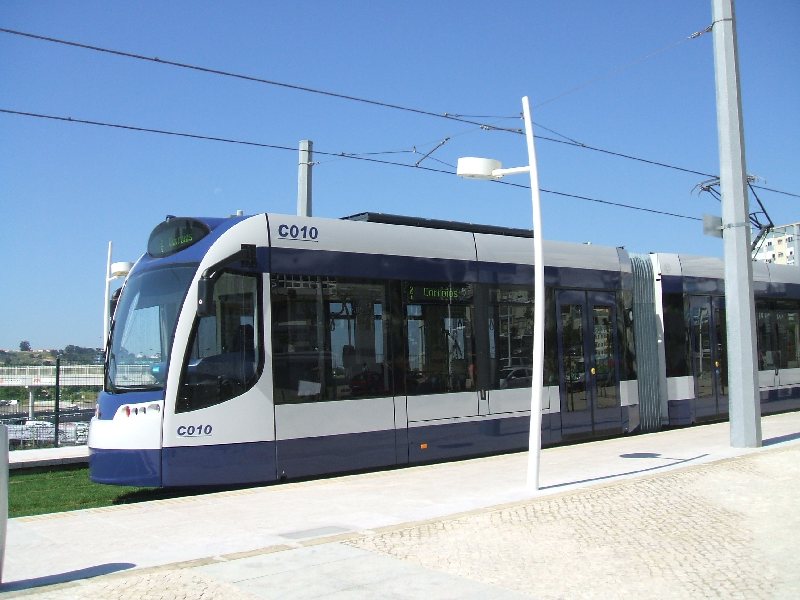
Pictured above a week after the line's opening is an MST vehicle at the initial terminus of Cova da Piedade to which services ran from Corroios.
The Metropolitano Ligeiro da Margem Sul do Tejo (MST) is a light-rail system on the south bank of the River Tagus, which is planned to have four lines totalling 27.65km and with 37 stations. The route itself is through housing and shops for the most part, with all the track being reserved from the adjacent roadway.
Work on the system started in April 2003 and MST operations were scheduled to start in December 2005 - but, although running trials began in November 2005, the official opening only came on 30 April 2007, with revenue-earning services starting the next day, 1 May, on the 5km section between Corroios and Cova da Piedade only. This journey takes 11 minutes and represents an investment of 95 million Euros for this section. The second phase, from Corroios to Universidade was fully opened on 15 December 2007, whilst the final phase will see the completion of the line with the opening of the Cova da Piedade to Cacilhas section.
For those crossing the river from Lisbon, the MST can now be joined at Pragal or Corroios stations on the Fertagus railway line from Lisbon to Setúbal.
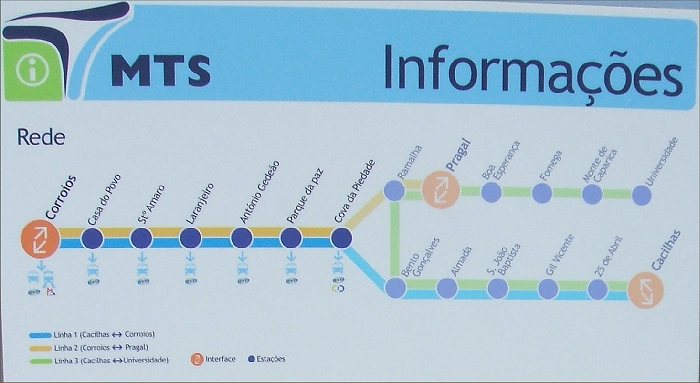
The above map, as displayed at MST stations in summer 2007 shows the seven stations opened by then, whilst those still to be put into use (on the right) are shown in lighter type.
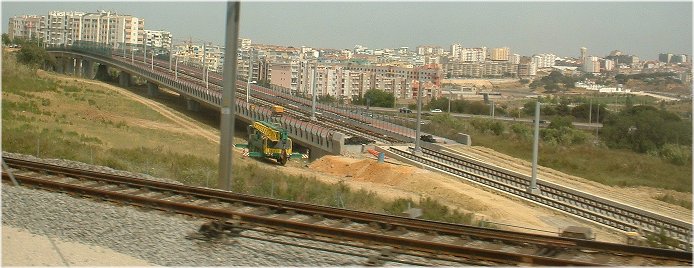
Above: The Metro Sul do Tejo line viaduct near Pragal, where it crosses under the Fertagus cross-Tagus line, in June 2005. The viaduct takes the Metro line over the autoestrada (motorway) which runs south from the Tagus bridge.
As of January 2008, the weekend service was being run by four cars. The timetable for weekends and holidays at that time was a 15 minute frequency between Corroios and Pragal and a half-hour frequency between Corroios and Universidade.

Above, courtesy of Owen Brison is a photo from January 2008 of unit C021 at Fomega, heading in the direction of Universidade. This station is in a cutting, and is surrounded at the level from where the picture has been taken by a large roundabout.
The network will be all double-track, 750V dc.and stops are generally about every 450 metres at platforms just 25cm high and 45m long. The MST vehicles have total traffic priority over road vehicles.
The planned network comprises:
- Linha 1 (Blue) - Cacilhas (Caneção) via Corroios. The total route distance will be 7km with 13 stops. ( c5 min. frequency)
- Linha 2 (yellow) - Pragal to Corroios (5.6km, 9 stops, 10 min. peak frequency).
- Linha 3 (green) - Universidade do Monte de Caparica via Pragal to Cacilhas (6.5.km, 12 stops, 7.5 mins peak frequency). The link to Cacilhas is projected to open by November 2008, bringing investment to 268 million Euros and producing a network serving a population of almost 100,000 people.
- Fogueteiro via Seixal to Barreiro (proposed)
The Corroios via Cova da Piedade to Universidade section is easily accessed from Lisbon by catching the Fertagus line trains from Roma/Areeiro, Entrecampos, Sete Rios or Campolide as far as Corroios. The Corroios metro terminus is a few yards from the main exit from the station on the Setúbal-bound side of the station.
I am grateful to Owen Brison for a number of the updates on this page. Pictured below is Owen's view of the construction of the new station at Ramalha.

Below is a September 2007 view of unit C024 at António Gedeão station, courtesy of Owen Brison. The water tower is also visible on the skyline in one of the photos higher up this page.
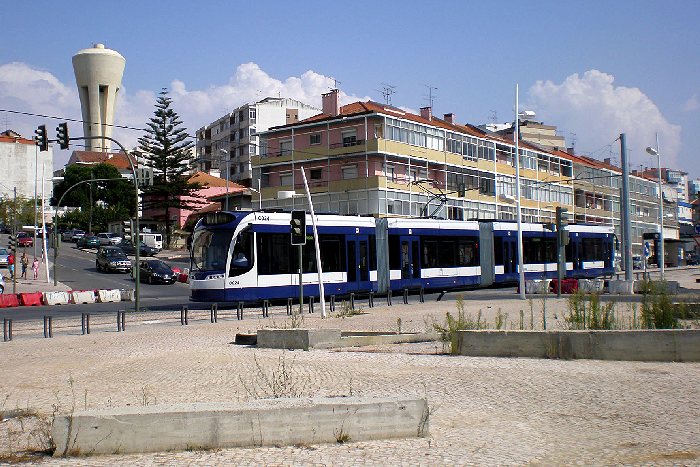
Vehicles
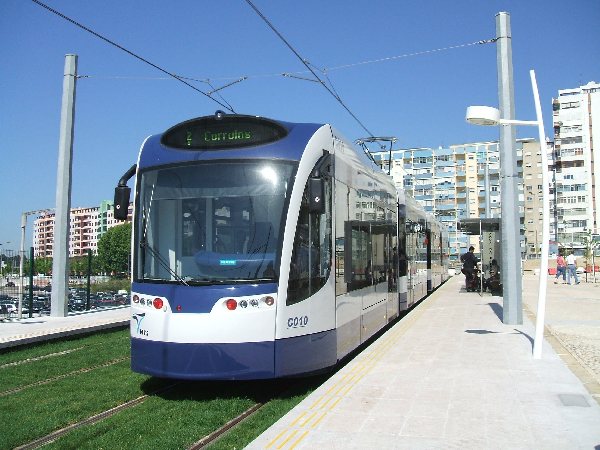
Above the MST is seen in operation at Cova da Piedade, in May 2007- barely a week after opening of the system.
Following the withdrawal of Alstom, the two bidders for the MST system were MAR, comprising ADtranz with the Incentro tram, and MTS (Metro Transportes do Sul). MTS is closely associated with Fertagus, as both include the Vivendi company. MTS won the bid and 24 Siemens five-section Combinos, each holding 74 seated and 181 standing passengers (at 4 person per square metre), are being used. Their maximum speed is 70 km/hour and each unit has five doors on each side. The units are driveable from either end and have a low floor profile of 330mm along the full length of the vehicle, which is air conditioned. Seating includes areas reserved for wheelchairs and pushchairs and their is a communication system for pasengers with the driver, as well as internal electronic indicators didpalying the next stop.
The vehicles have light and attractive interiors. Ticketing is based on the Sete Colinas proximity card, (see the Carris page for more on this). The card costs 0.50 euros and can be charged and re-charged with cash. Currently a ticket valid for an hour costs 0.85 euros or 0.75 if pre-purchased. There is a staffed ticket office at Corroios but the other stations all have automatic ticket machines which also have a recharging facility for the Sete Colinas card. All stations also have electronic time indicators indicating when the next three vehicles will arrive. In May 2007 vehicles were operating at slightly irregular intervals but roughly every four minutes on average.
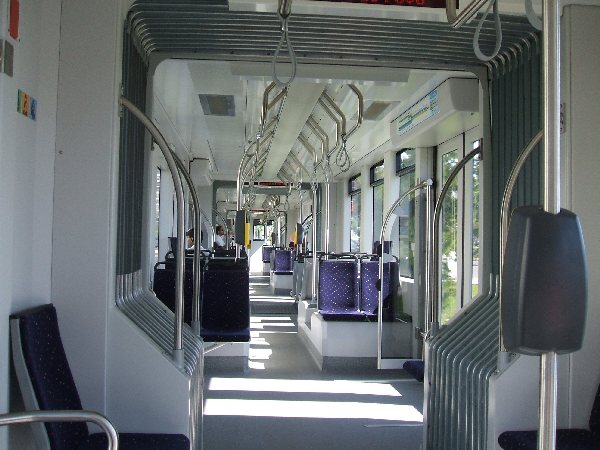
Inside an MST vehicle.
Copyright: ©
Contact: the following is not a link; please transcribe the address into your email 

 14 January 2008
14 January 2008








